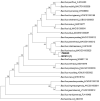Evaluation of Bacillus paramycoides Strains Isolated from Channa Fish sp. on Growth Performance of Labeo rohita Fingerlings Challenged by Fish Pathogen Aeromonas hydrophila MTCC 12301
- PMID: 37110265
- PMCID: PMC10141853
- DOI: 10.3390/microorganisms11040842
Evaluation of Bacillus paramycoides Strains Isolated from Channa Fish sp. on Growth Performance of Labeo rohita Fingerlings Challenged by Fish Pathogen Aeromonas hydrophila MTCC 12301
Abstract
Probiotics play vital roles in improving growth, survival, and immune responses and inhibit the growth of pathogenic bacteria in freshwater fish. This study was conducted to isolate potential probiotics from Channa punctatus and Channa striatus and to evaluate their effect on Labeo rohita fingerlings. Among the isolates, Bacillus paramycoides PBG9D and BCS10 (1) exhibited antimicrobial activity against the fish pathogen Aeromonas hydrophila. Both strains showed tolerance to acidic and alkaline pH (2, 3, 4, 7, and 9) and bile salts (0.3%) and exhibited strong adhesion capacity. After in-vitro assessment, these strains were evaluated on the growth performances of rohu fingerlings challenged by Aeromonas hydrophila for 4 weeks. The study consisted of six groups, each containing 6 fish. Group (I) was the control, fed a basal diet; group (II) contained a pathogen and was also fed a basal diet; group (III & IV) was given a probiotic supplemented experimental diet; Fourth group (V & VI) contained a pathogen and was given a probiotic supplemented experimental diet. After the 12th day of experiment, rohu fingerlings of pathogen (II) and probiotic + pathogen (V & VI) groups were intraperitoneally injected with 0.1 mL of Aeromonas hydrophila. After 4 weeks, no significant differences in weight gain, weight gain %, and feed conversion ratio were observed in probiotic (III & IV)- fed groups compared to control. However, the specific growth rate was significantly improved in probiotic fed groups compared to other groups. Survival rate and condition factor were significantly similar in all groups. After injection, abnormal swimming, loss of appetite and weight loss were observed in the pathogen (II) group, while no such symptoms were found in the probiotic + pathogen (V & VI)- groups, confirming the effects of probiotics. The overall results of the study revealed that dietary supplementation with Bacillus paramycoides strains could improve the specific growth rate and disease resistance against Aeromonas hydrophila in Labeo rohita.
Keywords: Aeromonas hydrophila; Bacillus paramycoides; Labeo rohita; antimicrobial activity.
Conflict of interest statement
The authors declare no conflict of interest.
Figures






Similar articles
-
Isolation of potential probiotic Bacillus spp. and assessment of their subcellular components to induce immune responses in Labeo rohita against Aeromonas hydrophila.Fish Shellfish Immunol. 2015 Aug;45(2):268-76. doi: 10.1016/j.fsi.2015.04.018. Epub 2015 Apr 25. Fish Shellfish Immunol. 2015. PMID: 25917974
-
Evaluation of In Vivo Probiotic Efficiency of Bacillus amyloliquefaciens in Labeo rohita Challenged by Pathogenic Strain of Aeromonas hydrophila MTCC 1739.Probiotics Antimicrob Proteins. 2018 Jun;10(2):391-398. doi: 10.1007/s12602-017-9310-x. Probiotics Antimicrob Proteins. 2018. PMID: 28744833
-
Protective Effects of Chlorella vulgaris Supplemented Diet on Antibacterial Activity and Immune Responses in Rohu Fingerlings, Labeo rohita (Hamilton), Subjected to Aeromonas hydrophila Infection.Life (Basel). 2023 Apr 16;13(4):1028. doi: 10.3390/life13041028. Life (Basel). 2023. PMID: 37109557 Free PMC article.
-
Effect of cellular products of potential probiotic bacteria on the immune response of Labeo rohita and susceptibility to Aeromonas hydrophila infection.Fish Shellfish Immunol. 2015 Oct;46(2):716-22. doi: 10.1016/j.fsi.2015.08.012. Epub 2015 Aug 14. Fish Shellfish Immunol. 2015. PMID: 26282681 Clinical Trial.
-
Dietary protein enhances non-specific immunity, anti-oxidative capability and resistance to Aeromonas hydrophila in Labeo rohita fingerlings pre-exposed to short feed deprivation stress.Fish Shellfish Immunol. 2016 Dec;59:439-446. doi: 10.1016/j.fsi.2016.10.052. Epub 2016 Nov 1. Fish Shellfish Immunol. 2016. PMID: 27815199
Cited by
-
Evaluation of Bacillus sp. strain isolated from pesticide influenced rhizospheric soil for dimethoate degrading potential.Braz J Microbiol. 2025 Jun;56(2):1191-1201. doi: 10.1007/s42770-025-01648-3. Epub 2025 Mar 1. Braz J Microbiol. 2025. PMID: 40025385
-
Bacillibactin, a Potential Bacillus-Based Antibacterial Non-Ribosomal Peptide: In Silico Studies for Targeting Common Fish Pathogens.Int J Mol Sci. 2025 Jun 17;26(12):5811. doi: 10.3390/ijms26125811. Int J Mol Sci. 2025. PMID: 40565273 Free PMC article.
References
-
- Kühlwein H., Merrifield D.L., Rawling M.D., Foey A.D., Davies S.J. Effects of dietary β-(1,3)(1,6)-D-glucan supplementation on growth performance, intestinal morphology and haemato-immunological profile of mirror carp (Cyprinus carpio L.) J. Anim. Physiol. Anim. Nutr. 2014;98:279–289. doi: 10.1111/jpn.12078. - DOI - PubMed
-
- FAO . The State of World Fisheries and Aquaculture. Sustainability in Action; Rome, Italy: 2020.
-
- Nandeesha M.C., Sentilkumar V., Antony Jesu Prabhu P. On-Farm Feeding and Feed Management in Aquaculture. FAO Fisheries and Aquaculture Technical Paper. FAO; Rome, Italy: 2013. Feed Management of Major Carps in India, with Special Reference to Practices Adopted in Tamil Nadu; pp. 433–462.
-
- Majumder S., Saikia S.K. Ecological intensification for feeding rohu Labeo rohita (Hamilton, 1822): A review and proposed steps towards an efficient resource fishery. Aquac. Res. 2020;51:3072–3078. doi: 10.1111/are.14669. - DOI
-
- FAO . In: Cultured Aquatic Species Information Programme. Labeo rohita. Jena J.K., editor. FAO Fisheries and Aquaculture Department, Food and Agriculture Organization of the United Nations; Rome, Italy: 2006. pp. 1–11.
LinkOut - more resources
Full Text Sources

